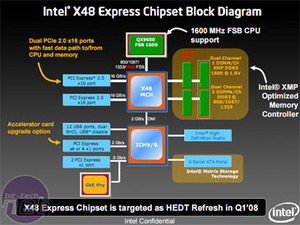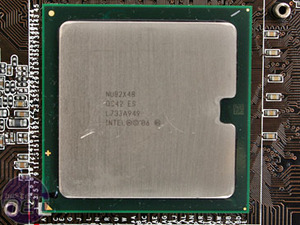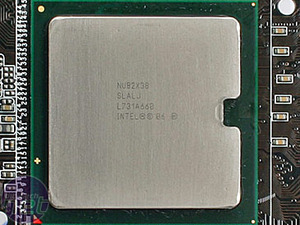First Look: Intel's X48 Chipset
Let's be honest here, X38 had the hype machine pumping since Pre-CeBit, promising us untold performance increases from DDR3 and super new features including things like PCI-Express 2.0. Not only was it late, but boards arrived in dribs and drabs and it's been nothing but a let down for many reasons:- We've found overclocking to be a little better, but some manufacturers are achieving equivalent overclocks from P35 boards.
- DDR2 performance was poor and was sometimes worse than P35, which made it a more expensive motherboard for less if you didn't care about gaming.
- X38 concentrated on DDR3 - Intel and memory manufacturers are pushing this massively because it's easier to design for and everyone making DDR2 memories is seeing red right now because prices have fallen through the floor. This is fantastic for consumers as 4GB of quality DDR2 memory will now cost you under £80, but it also means DDR3 is very expensive by comparison.
- As with all the previous graphical interface transitions: AGP 4x to 8x, AGP 8x to PCI-Express 1.0 and now PCI-E Gen 1 to Gen 2, there's no real performance increase for most of us, just more bandwidth to grow into.
- Getting DDR2 boards stable has been more difficult, it seems, with the few DDR2-based X38 boards we've seen having problems at some point during our testing. In comparison, DDR3-based X38 boards have been fine.
- Rumours of X48's arrival such a short time after X38 has put people off, yet, there's still no firm date for X48's official release - it was slated for early December and now some say January, while others say February.
As a result, Intel has turned around a new chipset part: the X48 northbridge. It has an almost identical featureset to the X38 northbridge, including support for XMP. However, interestingly it looks like XMP is only supported with two DIMMs only, meaning if you want 4GB @ 1,600MHz using four DIMMs, you're going to be out of luck.
X48 is still paired with the ICH9 southbridge that first saw life with P35, it has six PCI-Express Gen-1.0 x1 slots, six SATA 3Gbps with Intel Matrix RAID support, HD Azalia Audio and 12 USB 2.0 ports. The Intel Extreme Tuning Utility we've been waiting for since pre-X38 looks like it has been pushed back to launch with X48 as well. It'll be interesting to compare overclocking utilities once this arrives seeing as Intel is actually last to market with this kind of utility, being well behind Nvidia's nTune and AMD's new OverDrive utility.
It has very similar core features and is even built on the same (90nm) process as X38, so what else is there? Talking to Asus about the board, we were told that the only major benefit is when you use the memory OC modes and really ramp up the memory speed to 1,800 or 2,000MHz.
OK, hold up a sec... you're telling me that the only real benefit we're likely to see is not even from standard Intel specification and I'd have to go out and spend £400+ on performance DDR3 to achieve this? So is the X48 not the hot and spicy option that we expect? Instead of great tasting food you just go straight to the noxious and potentially explosive rear end result.
We learned from another motherboard manufacturer, Gigabyte, that it intends to move the X38 into more mainsteam products and only launch X48-based boards a premium models. We don't doubt that other manufacturers will also follow suit and this strategy is based on the anticipated prices of the chipsets in the future.
This should make an ideal setup for everyone - X48 will fit in right at the top end, offering niche performance and overclocking potential to only those willing to pay for it, X38 becomes the performance-mainstream chip that offers CrossFire and PCI-Express 2.0 at a much more affordable price and P35 gets dropped down into bargain basement territory. Ironically Intel has put itself in a unique but unenviable position: CrossFire should be more appealing with cheaper motherboards, which is better for AMD/ATI, but is this because Intel wants to squeeze Nvidia's 700-series chipsets due out next month? It looks like it has had to decide between a lesser of two evils.

MSI MPG Velox 100R Chassis Review
October 14 2021 | 15:04













Want to comment? Please log in.